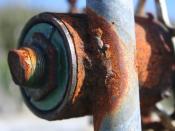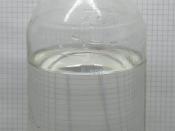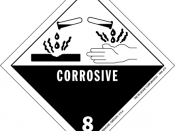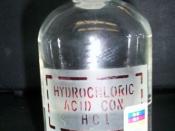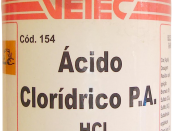Disappearing X Experiment
Introduction
I am going to investigate the rate of reaction between sodium thiosulphate (thio) and hydrochloric acid.
Hydrochloric Acid + Sodium Thiosulphate "" sodium chloride + water + sulphur
The reactants are both colourless, but one of the products, sulphur, is yellow, so we can use this fact to follow the rates of reaction. I am going to investigate how the concentration of the acid effects the speed of the reaction.
Apparatus
1 small measuring cylinder
1 large measuring cylinder
1 small beaker
1 large beaker
Hydrochloric Acid
Sodium Thiosulphate
Cross drawn on paper
Conical flask
Water
Stopclock
Method
First of all we measured out 25cm3 acid and 25cm3 sodium thiosulphate. Then we drew a cross onto a piece of paper and put an empty conical flask on top of the paper. Next, we poured the 25cm3 acid and 25cm3 thio into the conical flask and started the stop clock.
We timed how long it took for the solution to turn cloudy so that the cross could no longer be seen. We then decided to change the experiment to see if the concentration of the acid affected the rate of reaction. To do this we added water to the acid and did the experiment again 4 times, decreasing the concentration of the acid by 5cm3 each time. We did this by measuring out the acid in a beaker and pouring it into a measuring cylinder along with the water as well. We then added the contents of the cylinder to the conical flask along with the 25cm3 sodium thiosulphate.
Variables
I changed the concentration of the hydrochloric acid by adding water to it.
25 Acid / 0 Water / 25 thio
20 Acid / 5 Water / 25 thio
15 Acid / 10 Water / 25 thio
10 Acid / 15 Water / 25 thio
5 Acid / 20 Water / 25 thio
Instead of changing the concentration of the acid, we could have added water to the thio, like this:
25 Acid / 25 thio / 0 Water
25 Acid / 20 thio / 5 Water
25 Acid / 15 thio / 10 Water
25 Acid / 10 thio / 15 Water
25 Acid / 5 thio / 20 Water
We could also have changed the temperature of the thio before mixing it with the hydrochloric acid, or the temperature of the hydrochloric acid before mixing it with the thio.
Fair Testing
To ensure a fair test, I will make sure I keep the volume of the sodium thiosulphate the same, 25cm3. I will also make sure that I use the same cross on paper every time and not switch between a lightly drawn pencil cross and a heavy cross drawn in black marker, as this would affect the time taken for it to disappear. Also to ensure a fair test I will use the same beakers and measuring cylinders each time for holding the thio and the acid. This is because if I put the thio into a beaker that had previously held acid then it could start off a reaction and affect the overall reaction rate. Also, we need to wash the beakers and cylinders before using them as there could be another chemical left in the bottom. This could start off unwanted reactions and affect the reaction rate. Finally, we will make sure that the same person judges when the cross is no longer visible or the reaction times result could not be accurate, as 2 people could have different eyesight and therefore different opinions on when the x has disappeared.
Prediction
I predict that as I decrease the concentration of the hydrochloric acid, the reaction rate will get slower.
Explanation Of Prediction
I think that 25cm3 acid and 25cm3 thio will react faster than any of the solutions with a lower concentration of acid because there are more acid particles in the solution, which means more particle collisions, resulting in a faster reaction. If the solution is diluted, there aren't as many acid particles to collide with the thio particles and so the reaction is much slower.
Results
/mins
Acid/cm3Water/cm3Reaction Time 1Reaction Time 2Average Reaction Time
2501.522.332.12
2052.092.432.26
15102.242.542.39
10153.053.383.21
5204.585.555.26
/secs
Acid/cm3Water/cm3Reaction Time 1Reaction Time 2Average Reaction Time
250112153132.5
205129163146
1510144174159
1015185218201.5
520298355326.5
Analysis/Conclusion
We discovered that 25cm3 hydrochloric acid and 25cm3 sodium thiosulphate solution had the fastest reaction rate, just as we had predicted.
